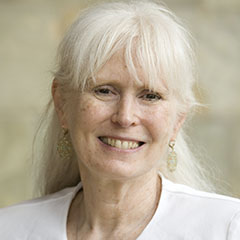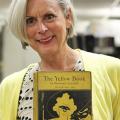Articles
Section Editor
This section publishes articles discussing the use of COVE by our users. Anyone wishing to publish an article in this section, should contact Paul Fyfe (paul.fyfe@ncsu.edu) and Dino Franco Felluga (felluga@purdue.edu). New articles are put through peer review and copy-editing before publication.
 Collaboration and Community Building with Print and Digital Platforms in the Remote Classroom
Collaboration and Community Building with Print and Digital Platforms in the Remote Classroom
Bettina Tate Pedersen explains that the pandemic reality of a fully remote Fall 2020 semester was the crucible that compelled her to try the COVE (Collaborative Organization for Virtual Education), a digital platform she had long been curious about and a bit afraid to adopt. Since her university, a small, private, religious institution, was fully remote all semester, she used a combination of synchronous and asynchronous meetings. She needed to find a way for her and her students to see passages together on a shared screen. COVE, in combination with Broadview editions, proved the solution.
![]()
 Adventures in Context & Curiosity: Annotating Crime Fiction with COVE
Adventures in Context & Curiosity: Annotating Crime Fiction with COVE
Keaghan Turner describes the pedagogical payoffs of incorporating the COVE annotation tool into undergraduate interdisciplinary courses generally populated by non-Humanities majors. She reflects on the value of annotation assignments in challenging students to level-up their collaborative and active engagement with late nineteenth-/early twentieth-century short fiction in both hybrid and distance learning formats.

Finding a Refuge for the Victorian Illustrated Book in the COVE
Catherine J. Golden discusses how the Central Online Victorian Educator toolset helped her to create an exhibition for a Skidmore College course entitled “The Victorian Illustrated Book.” Just as students were poised to design a library exhibition of rare books, serials, and prints in the forms they appeared to the Victorians when they were first issued, the pandemic hit. Golden reformulated the archival work her students would have done into a COVE Gallery exhibition. The end result is “The Victorian Menagerie,” a COVE exhibition that illustrates the ways the Victorians treated animals, anthropomorphized them, put animals on display, and made animals an indelible part of Victorian culture.
 Trial and Success: A Non-DH Savvy Professor Adopts COVE
Trial and Success: A Non-DH Savvy Professor Adopts COVE
Laura Rotunno discusses how her teaching of two classes at Penn State Altoona were augmented and improved through the use of COVE tools. One upper-division course made use of the timeline and map tools to examine woman’s suffrage in literature and culture; one lower-division survey class made us of the annotation tool at COVE Studio to improve students’ ability to read, understand and interpret literature.
 Teaching Time
Teaching Time
Dino Franco Felluga discusses his efforts to test the temporal extension and collaborative potential of the timeline tool in two courses on the transition from the Medieval period to the Renaissance, one titled Making the Human, the other Leonardo da Vinci (both taught for Purdue’s Honors College). Each class had about 20 students who undertook a collective timeline project, each student contributing a certain number of timeline elements as research preparation for their final papers. As one student in Prof. Felluga’s Making the Human course put it spring 2017, echoing responses from the others in the class, “This type of collaboration was not only great for learning and providing a plethora of useful information, but was also very easy and was not stressful like some collaborations are.” (This link shows off the class interface for Making the Human.)

Teaching Transformation
Lorraine Janzen Kooistra discusses using the COVE toolset in her graduate class on Digital Publishing to create a collaborative digital edition of Clemence Housman’s The Were-Wolf as an open-access, peer-reviewed scholarly text for classroom use. Published by John Lane at The Bodley Head in 1896, the novella was itself the outcome of a collaborative process. In addition to authoring the story, Clemence engraved the illustrations created by her brother, Laurence, who also designed the book. The theme for this course was transformation. Just as the werewolf has long been a trope of transformation in the popular imagination, so too have the transformative powers of re-presentation and re-mediation always informed the ways we produce and read texts. Transformed into an editorial team, the class of 13 students worked together to prepare the copy-text for the edition, annotate its text and images, create temporal and geographic visualizations relevant to its content, and contribute to the edition’s editorial apparatus. The course used experiential learning and applied practice to develop students’ understanding of textual editing, the digital humanities, and Victorian publishing.

The Echoing Cry
Joshua King describes how COVE can be used in two types of pedagogical projects and exercises. First, he recounts how he and students used COVE to bring coherence to an in-depth exhibition about Elizabeth Barrett Browning's (EBB) poem, "Cry of the Children." The exhibition combines traditional display cases (containing manuscripts, letters, rare books, and three-dimensional objects) with user-activated videos and, crucially, two COVE stations: a timeline and geospatial map. Second, he describes how this and other learning objectives can be supported through live-annotation sessions with students using COVE studio. The COVE-supported student exhibition focuses on the background, contexts, composition, reception, and enduring relevance of EBB's protest against child labor in factories and mines. Entitled "'Orphans of earthly love': Elizabeth Barrett Browning's Protest for Working Children," it will be mounted at Baylor University's Armstrong Browning Library (ABL, Waco, Texas), which possesses the world's largest collection of manuscripts and rare items related to the Brownings, along with artifacts of many other important nineteenth-century authors and cultural figures. The exhibition opening will coincide with a multi-site, digitally interconnected symposium in honor of the 175th anniversary of EBB's poem (October 2018) hosted by the ABL, the University of Victoria (Canada), and the University of Strathclyde (Scotland). A long-term digital version of the exhibition will be loaded to this event's website, where it will be synthesized with materials provided by Victoria and Strathclyde.
 Access and Equity: Annotation as Translation with COVE Annotation Studio
Access and Equity: Annotation as Translation with COVE Annotation Studio
Kenneth C. Crowell outlines the structure of his blended delivery British Literature survey—the first course incorporating COVE Annotation Studio in the classroom—and discusses how use of Annotation Studio as a collaborative online space increases equity and lessens barriers to access for students, particularly non-English majors. He includes in discussion a commentary on cross-platform integration and user experience, the viability of Annotation Studio as a presentational software platform, and student responses to the use of Annotation Studio within a blended delivery course model. Noting the positive student feedback for Annotation Studio as a medium for collaborative learning, his paper suggests ultimately that Annotation Studio’s public platform inspires students to take ownership of the reading act, and by doing so, raise the stakes and quality of their analyses.
 Drawn to Books: Augmenting Brick-and-Mortar Exhibitions with COVE
Drawn to Books: Augmenting Brick-and-Mortar Exhibitions with COVE
Rebecca N. Mitchell describes the ways that the COVE platform can be used to complement a brick-and-mortar exhibition that was partly curated by students. ‘Drawn to Books: Women Illustrators of the Birmingham School’ explores the role of the progressive Birmingham School of Art, England’s first municipal art school, in shaping the careers of women artists, designers, and illustrators. Built on the iconographic foundation of the Pre-Raphaelites, the Birmingham School style incorporated flattened perspective and medieval subjects with a fin de siècle emphasis on black space and orientalism. Students selected works for the exhibition and wrote captions and gallery notes for an exhibition held at Winterbourne House and Garden on the University of Birmingham campus. With the COVE toolset, students from the course are preparing a timeline and gallery that will showcase the Birmingham School works in a more widely accessible medium.
